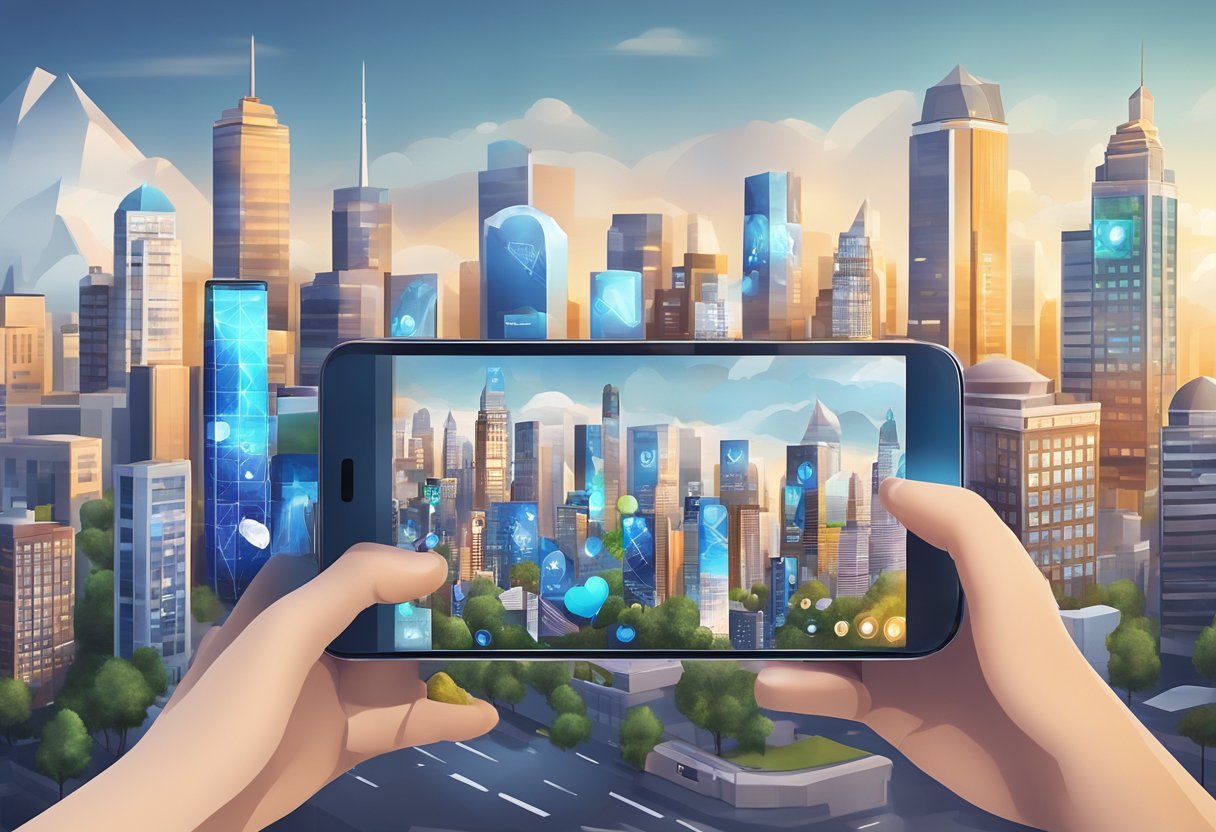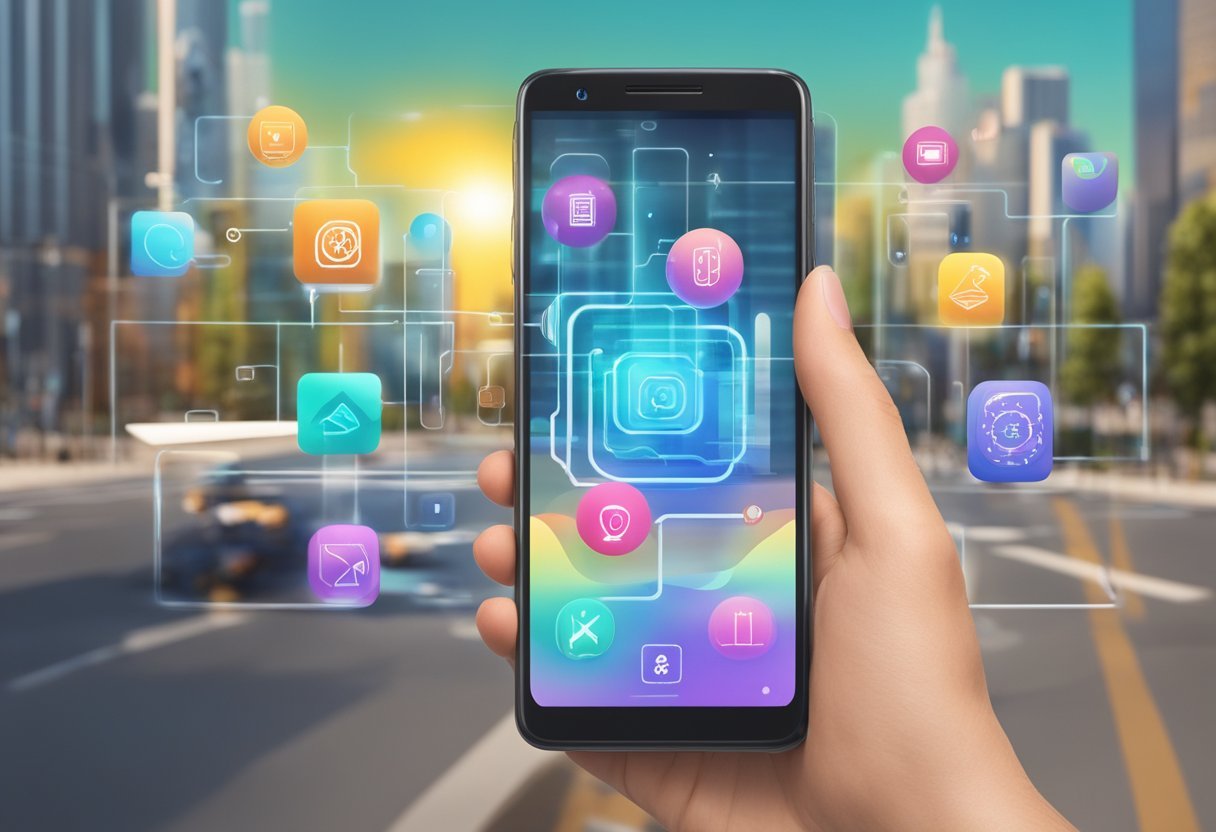Augmented reality (AR) is an innovative technology that overlays digital content onto the real world. AR marketing is a new way of advertising that allows brands to create interactive and immersive experiences for their customers. By using AR technology, marketers can provide a personalized and engaging experience that helps increase brand awareness, loyalty, and sales. In this article, I will share with you a comprehensive guide to augmented reality for marketing. I will share with you step by step guide of how to get started with AR marketing, tools to use and the benefits.
AR technology can be used in a variety of ways to enhance marketing campaigns. For example, it can be used to create interactive product demonstrations, virtual try-ons, and 3D product visualizations. AR can also be used to create location-based experiences, such as scavenger hunts or virtual tours. By using AR in marketing, brands can create a unique and memorable experience that sets them apart from their competitors.
Consumers are increasingly looking for more engaging and personalized experiences with brands. AR marketing offers a way to meet this demand by providing an interactive and immersive experience that captures the attention of consumers. By leveraging AR technology in their marketing campaigns, brands can increase engagement, build brand loyalty, and ultimately drive sales.
What is AR in marketing?
Augmented Reality (AR) is a technology that overlays digital information onto the real world. It has become a popular tool for marketers to create interactive and engaging experiences for their customers. By using AR, brands can blend the physical and digital worlds to create a unique and immersive experience for their customers.
AR has been used in marketing campaigns for a variety of industries, including retail, automotive, and entertainment. It has been used to showcase products in a more interactive way, provide customers with more information, and create a more memorable experience.
Augmented Reality Marketing technology
AR technology has come a long way in recent years, and there are now a variety of tools and platforms available to help brands create AR experiences. Some of the most popular platforms include ARKit, ARCore, and Vuforia. These platforms allow developers to create AR experiences that can be used on a variety of devices, including smartphones and tablets.
One of the biggest advantages of AR in marketing is its ability to provide customers with a more immersive experience. By using AR, brands can create experiences that are more engaging and memorable than traditional marketing methods. This can help to increase brand awareness and customer loyalty.
In addition, AR can also be used to provide customers with more information about products. For example, a customer could use an AR app to scan a product and receive information about its features and benefits. This can help to increase customer satisfaction and reduce the number of returns.
How to use Augmented Reality for marketing

A step-by-step guide on how to use AR for marketing:
- Define Your Objectives: Clearly identify what you want to achieve with your AR marketing campaign. Whether it’s increasing brand awareness, boosting engagement, or driving sales, your objectives will guide the development of your AR experience.
- Understand Your Audience: Know who your target audience is and what type of AR experiences they might find appealing and useful. This will help tailor your AR content to their interests and behaviors.
- Choose the Right Platform: Decide whether to develop your AR experience on a standalone app, through social media platforms with AR capabilities, or through web-based AR which doesn’t require an app download.
- Develop Engaging Content: Create AR content that is interactive, immersive, and adds value to the customer experience. The content should be aligned with your brand message and objectives.
- Ensure Accessibility: Make sure your AR experience is easy to access and use. It should require minimal steps to activate and be compatible with a wide range of devices.
- Integrate with Other Marketing Channels: Your AR campaign should not exist in isolation. Integrate it with your existing marketing efforts, such as social media, email marketing, and in-store promotions.
- Test and Optimize: Before launching, test your AR experience to ensure it works smoothly across different devices and is free from glitches. Collect feedback and make necessary adjustments.
- Launch Your Campaign: Once your AR experience is polished and ready, launch it to your audience. Use various marketing channels to promote its availability.
- Measure Performance: Track the performance of your AR campaign against your initial objectives. Analyze user engagement, conversion rates, and any other relevant metrics.
- Gather Feedback and Iterate: Collect user feedback to understand what worked and what didn’t. Use this information to improve future AR marketing efforts.
Requirements for Augmented Reality marketing:
- A clear understanding of your marketing goals and target audience
- A creative concept that enhances the customer experience
- A platform for deploying the AR experience, such as a mobile app or social media
- AR content creation tools or partnerships with AR developers
- Compatibility with a wide range of devices for broad accessibility
- Integration capabilities with existing marketing strategies and channels
- A plan for promoting the AR experience to your audience
- Analytics tools to measure the success of the AR campaign
- A process for collecting user feedback
- Resources for ongoing support and updates to the AR content
10 AR marketing examples:
- Virtual try-on for cosmetics, glasses, or fashion items
- Interactive billboards or outdoor advertising campaigns
- AR-enhanced print catalogs or brochures
- Immersive product demonstrations or tutorials
- Gamified AR experiences for customer engagement
- AR treasure hunts or scavenger hunts for promotions
- Location-based AR experiences for personalized offers
- Social media filters or lenses for brand campaigns
- Interactive packaging with AR content
- Virtual showrooms or store tours
Companies using augmented reality for marketing
- IKEA
- Sephora
- Nike
- L’Oréal
- Pepsi
IKEA
IKEA, the Swedish-founded multinational group that designs and sells ready-to-assemble furniture, kitchen appliances, and home accessories, has been a pioneer in using AR for marketing. Their IKEA Place app allows customers to visualize how furniture and decor will look and fit in their own homes with remarkable accuracy. Users can select from an extensive catalog of products and place 3D models of IKEA furniture in their space using the camera on their smartphones or tablets. This AR experience helps customers make more informed decisions by providing a ‘try before you buy’ option, reducing the uncertainty that often accompanies furniture shopping.
The app also encourages users to experiment with different styles, leading to increased engagement and customer satisfaction. By leveraging AR, IKEA has successfully bridged the gap between the online and offline shopping experience, driving sales and reinforcing its reputation as an innovative and customer-centric brand.
Sephora
Sephora, a leader in global prestige retail, has embraced AR to revolutionize the way customers experience beauty. Their ‘Virtual Artist’ feature, available on the Sephora app, uses facial recognition technology to allow customers to try on thousands of shades of makeup virtually. The feature includes options for trying on products like lipsticks, eyeshadows, and false lashes in real time, simulating the in-store experience without the need for physical product testing.
This not only enhances the shopping experience by making it more interactive and fun but also allows Sephora to offer a personalized service, recommending products based on the user’s virtual try-ons. The AR tool has proven to be a valuable addition to Sephora’s digital marketing strategy, increasing consumer engagement, and driving sales both online and offline.
Nike
Nike, the world-renowned sportswear brand, has effectively incorporated AR into its marketing strategy to create buzz and provide exclusive experiences. One notable use of AR was for the launch of the Nike SB Dunk High Pro “Momofuku” sneakers, where customers could only purchase the shoe by pointing their smartphone camera at a menu of David Chang’s Momofuku restaurant or a specific image online to unlock it.
Nike has also used AR to enhance the customer experience in their Nike Fit feature, which helps users find the perfect shoe size by scanning their feet with a smartphone camera. This innovative use of AR technology not only drives sales through unique promotional tactics but also aids customers in making better purchasing decisions, reducing the likelihood of returns due to sizing issues. Nike’s use of AR in marketing underscores their commitment to innovation, both in their products and in the way they connect with customers.
L’Oréal
L’Oréal, the world’s largest cosmetics company, has harnessed AR to transform the beauty industry’s approach to marketing. With their acquisition of the AR beauty tech company ModiFace, L’Oréal has implemented AR across several of its brands. For instance, their ‘Virtual Try-On’ feature allows users to test different hair colors and makeup products virtually before making a purchase.
This tool is available on L’Oréal’s website and partner retail sites, as well as through mobile apps, making it widely accessible. By integrating AR into the consumer’s shopping journey, L’Oréal delivers a personalized and engaging experience that helps build consumer confidence in their products. The company’s AR initiatives not only enhance the online shopping experience but also drive sales and foster a deeper connection with their customers.
Pepsi
Pepsi, the globally recognized beverage company, has utilized AR to create memorable marketing campaigns that engage consumers in unique ways. One of their most talked-about AR experiences was the ‘Unbelievable’ bus shelter advertisement in London, which surprised commuters with seemingly real-life scenarios, such as a giant robot walking down the street or a tiger on the loose, appearing on the screen that served as the shelter’s wall.
This campaign generated immense buzz and shared widely across social media, showcasing Pepsi’s ability to craft innovative and immersive brand experiences. Through AR, Pepsi has managed to capture the attention of consumers and create viral moments that enhance brand awareness and affinity. Their foray into AR marketing demonstrates how traditional advertising can be reimagined to captivate audiences in the digital age.
Augmented Reality Marketing Research

As augmented reality (AR) technology continues to grow in popularity, it has become an increasingly popular tool for marketing. AR marketing research has been conducted to analyze the current and evolving research profile of AR marketing scholarship, as well as its social and conceptual structures to inspire further research.
AR marketing research has shown that AR technology can have a profound impact on a variety of marketing practices. AR technology can be used to create immersive experiences that allow consumers to interact with products in new and exciting ways. This can lead to increased engagement, brand awareness, and ultimately, sales.
Virtual reality (VR) and AR technologies are often used interchangeably, but they are not the same. While VR is a fully immersive experience, AR overlays digital information onto the real world. AR technology has been used in marketing to create interactive advertisements, product demonstrations, and even virtual try-on experiences.
AI and sensors are also important components of AR marketing research. AI can be used to analyze consumer data and provide personalized recommendations, while sensors can be used to track consumer behavior and provide valuable insights into consumer preferences.
AR marketing research has shown that AR technology has the potential to revolutionize the way that companies market their products. By creating immersive experiences that allow consumers to interact with products in new and exciting ways, companies can increase engagement, build brand awareness, and ultimately, increase sales.
Benefits of Augmented Reality in Marketing
Augmented Reality (AR) has become an increasingly popular technology in recent years, especially in the marketing industry. AR offers a unique way to engage with customers, making it an effective tool for marketers to promote their products and services. Here are five benefits of using AR in marketing:
1. Enhanced Customer Experience
AR technology allows customers to interact with products in a more immersive way. By using AR, customers can visualize how a product would look like in real life, which can help them make more informed purchase decisions. This enhanced experience can lead to higher customer satisfaction and loyalty, ultimately leading to increased sales.
2. Increased Engagement
AR can help increase customer engagement by providing an interactive experience that encourages them to spend more time with a product. This increased engagement can lead to increased brand awareness and customer loyalty. AR can also be used to create gamified experiences, which can be a fun way to promote a product or service.
3. Cost-Effective
AR can be a cost-effective way to promote products and services. Unlike traditional marketing methods, AR does not require physical materials such as brochures or flyers. AR can be integrated into existing marketing campaigns, making it a cost-effective way to enhance the customer experience.
4. Future-Proof
AR is an emerging technology that is expected to grow rapidly in the coming years. By investing in AR now, marketers can future-proof their marketing campaigns and stay ahead of the competition. AR can also be used to create innovative marketing campaigns that stand out from the crowd.
5. Improved Analytics
AR can provide valuable analytics data that can be used to improve marketing campaigns. By tracking customer interactions with AR experiences, marketers can gain insights into customer behavior and preferences. This data can be used to optimize marketing campaigns and improve the overall customer experience.
AR offers a unique way to engage with customers and promote products and services. By using AR, marketers can enhance the customer experience, increase engagement, reduce costs, future-proof their marketing campaigns, and gain valuable analytics data. As AR continues to grow and evolve, it is expected to become an increasingly important tool in the marketing industry.
Strategic Implementation in Marketing
Augmented reality (AR) has become an emerging trend within marketing and sales strategies. As a marketer, incorporating AR into your advertising campaigns can provide your customers with unique experiences that can enhance brand value. Here are two ways to strategically implement AR in your marketing strategies.
Incorporating AR in Advertising Campaigns
AR can be used in advertising campaigns to create interactive and immersive experiences for customers. For example, AR can be used to create virtual product demonstrations or allow customers to visualize products in their own environment. By incorporating AR into advertising campaigns, you can provide customers with a unique and memorable experience that can increase engagement and drive sales.
Enhancing Brand Value with AR
AR can also be used to enhance brand value by providing customers with an interactive and engaging experience. For example, AR can be used to create interactive product manuals or provide customers with educational content about your products. By using AR to enhance brand value, you can create a more personal and emotional connection with your customers, which can lead to increased loyalty and brand advocacy.
Incorporating AR into your marketing strategies can provide your customers with unique and memorable experiences that can enhance brand value. By strategically implementing AR in your advertising campaigns and enhancing brand value with AR, you can create a more engaging and personal connection with your customers.
AR for Consumer Engagement and Sales
Augmented Reality (AR) technology has revolutionized the way businesses interact with their customers, providing an immersive and interactive experience that enhances engagement and drives sales. Here are two ways AR can be used to improve consumer engagement and sales:
Improving Shopping Experiences
AR technology can be used to create engaging and interactive shopping experiences, allowing customers to visualize products in 3D and in real-time. This helps customers make more informed purchasing decisions, leading to higher customer satisfaction and repeat business.
AR can also be used to provide customers with additional product information, such as product specifications, reviews, and pricing information. This helps customers make more informed purchasing decisions and increases the likelihood of a sale.
Influencing Purchase Decisions
AR technology can be used to influence purchase decisions by providing customers with a more immersive and engaging experience. For example, AR can be used to create virtual try-on experiences for clothing and accessories, allowing customers to see how products look on them before making a purchase.
AR can also be used to create personalized recommendations based on a customer’s preferences and purchase history. This helps customers find products that are relevant to their interests and increases the likelihood of a sale.
Case Studies of AR in Marketing
Retail Giants and AR
Retail giants like IKEA, Sephora, and Starbucks have successfully implemented augmented reality (AR) in their marketing strategies. IKEA’s AR app allows customers to visualize furniture in their homes before making a purchase, resulting in a 98% customer satisfaction rate. Sephora’s AR feature enables customers to try on makeup virtually, leading to a 200% increase in app downloads and a 11% increase in in-store sales. Starbucks’ AR game, which allowed customers to scan cups and win prizes, resulted in a 10% increase in sales.
Successful AR Marketing Campaigns
AR has also been used successfully in marketing campaigns. The NFL’s AR app, which allowed fans to take photos with virtual players, resulted in a 12% increase in social media engagement. Pepsi’s AR campaign, which featured a virtual soccer game, led to a 7.9% increase in sales.
AR has proven to be a valuable tool in marketing, allowing for increased customer engagement and satisfaction. As technology continues to advance, it is likely that more companies will incorporate AR into their marketing strategies.
Challenges and Considerations
When it comes to augmented reality for marketing, there are several challenges and considerations to keep in mind to ensure a successful implementation. In this section, we will discuss two key challenges: technical and budget constraints, and consumer privacy and data security.
Technical and Budget Constraints
One of the biggest challenges with implementing augmented reality for marketing is the technical and budget constraints that come with it. Augmented reality requires a high level of technical expertise and specialized hardware and software to create and deploy. As a result, it can be costly to develop and maintain an augmented reality marketing campaign.
In addition, the hardware required for augmented reality experiences, such as headsets or mobile devices, can be expensive for both businesses and consumers. This can limit the reach of an augmented reality marketing campaign and make it less accessible to a wider audience.
Consumer Privacy and Data Security
Another important consideration when implementing augmented reality for marketing is consumer privacy and data security. Augmented reality experiences often require access to sensitive personal data, such as location information and camera feeds. As a result, it is crucial to ensure that the data collected is protected and used responsibly.
To address these concerns, it is important to establish clear guidelines and policies around data collection and usage. This includes obtaining explicit consent from users before collecting any data and ensuring that the data is stored securely and used only for its intended purpose.
Frequently Asked Questions
How are companies integrating augmented reality into their marketing strategies?
Augmented reality (AR) is an emerging technology that has captured the attention of many businesses. Companies are integrating AR into their marketing strategies by creating interactive experiences for their customers. AR can be used to showcase products, provide virtual try-ons, and create immersive experiences that engage customers. Companies are also using AR to create memorable experiences at events and trade shows.
What are the key benefits of using augmented reality for marketing purposes?
The key benefits of using augmented reality for marketing purposes are increased engagement, brand awareness, and customer satisfaction. AR provides an interactive experience that allows customers to engage with products in a unique and memorable way. This can lead to increased brand awareness and customer loyalty. AR can also provide valuable data and insights into customer behavior and preferences.
Can you provide some successful examples of augmented reality campaigns in marketing?
There have been many successful examples of augmented reality campaigns in marketing. One example is the IKEA Place app, which allows customers to place virtual furniture in their homes to see how it would look. Another example is the Sephora Virtual Artist app, which allows customers to try on makeup virtually before making a purchase. These campaigns have been successful in increasing engagement and customer satisfaction.
How is augmented reality expected to evolve within the marketing industry?
Augmented reality is expected to continue to evolve within the marketing industry. As the technology becomes more advanced, companies will be able to create even more immersive experiences for their customers. AR is also expected to become more accessible, allowing smaller businesses to incorporate it into their marketing strategies. AR is expected to become more integrated with other technologies, such as artificial intelligence and virtual reality.
What role does augmented reality play in enhancing digital marketing efforts?
Augmented reality plays a significant role in enhancing digital marketing efforts. AR provides an interactive experience that allows customers to engage with products in a unique and memorable way. This can lead to increased brand awareness and customer loyalty. AR can also provide valuable data and insights into customer behavior and preferences, allowing companies to improve their digital marketing strategies.
How do augmented reality and artificial intelligence complement each other in marketing?
Augmented reality and artificial intelligence complement each other in marketing by providing a more personalized experience for customers. Artificial intelligence can be used to analyze customer data and provide personalized recommendations, while augmented reality can be used to provide an interactive experience that allows customers to engage with products in a unique and memorable way. Together, these technologies can provide a more personalized and engaging experience for customers.




